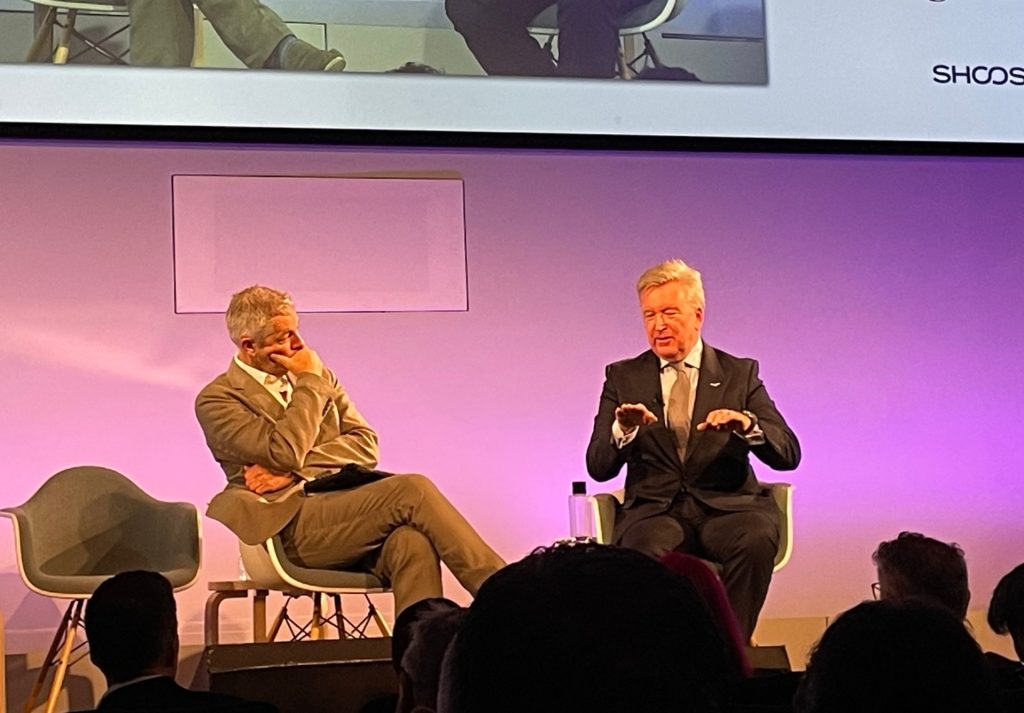At this week’s SMMT Automotive Summit, held at the Institute of Engineering & Technology, Adrian Hallmark, Chief Executive Officer, Aston Martin Lagonda shared his views on the current landscape of the automotive sector, including the current geopolitical landscape, recent trade deals, development and deployment of electric vehicles and the recently launched Industrial Strategy.
AH: For luxury companies around the world, there was an incredible boom in demand post-COVID. This has now normalised, and we’ve entered a period that some have described as the reversal of globalisation. This has led to a rapid fragmentation of global markets in a way that our business has never seen before.
That manifests itself in various challenges, one of which is technology barriers, with autonomous driving systems (ADAS) being a prime example; China has different requirements to the US and Europe, partly for security and partly for political reasons. The same applies to emissions standards. So there’s a whole plethora of new challenges and this fragmentation of what used to be a fairly consistent approach across the world – set on high standards – makes life difficult.
On another level, major OEMs and suppliers have invested massively in electrification over the past five to ten years. Volumes have not matched that investment and that means we’ve seen stress in the supply chain and in some of the OEMs’ profit and loss accounts, having invested billions to create capacities for those new technologies.
As a small player, we can’t imagine having electric and engine vehicles running in parallel, while also coping with three radically different regimes around the world in terms of EU, US and China.
Key takeaways
- Fragmentation of global markets has created challenges for automotive manufacturers
- Electric vehicle adoption has not been as expected in the UK
- Policy divergence and a lack of consistency has proved costly for automotive SMEs
- Three trade deals with the US, India and the EU have been big wins for the sector
- The rapidly changing environment makes planning difficult for the long product cycles in automotive
FAQs
- What does the world of automotive look like right now?
- How is industry and government working together to deliver the Industrial Strategy?
- What will the trade deals with the US, India and the EU mean for UK automotive?
- Where is the UK with electric vehicles?
- How can manufacturers plan in a challenging and rapidly changing environment?
That then brings us to policy, and there’s three areas which we’re looking at very closely. One is regulation, around emissions, cyber security and electronics in particular. The divergence in those regulations is highly costly to any manufacturer, particularly SMEs. So that’s a real issue.
The second challenge is to do with tariffs. They’ve always been there of course, but the rate of change at the moment and the effect that it can have on demand and profitability is causing a lot of uncertainty. However, there’s always opportunity, and now we’re less worse off than some of our European and non-European competitors, so we do have a small advantage.
The third issue with policy is around consistency. If you look at the last six years, we’ve gone from a banning of ICE engines in 2030, which then moved to 2035. There’s been additional changes in terms of hybrids, ZEV mandates and allowances for small vehicle manufacturers (which has actually been welcomed as we have a slight lag compared to the volume players). The issue is that these changes can happen in one to two years, compared to five for our own product cycles, so it’s very difficult to be flexible.
How important is it that Aston Martin, the industry and government work together on the Industrial Strategy?
The dialogue and the openness has been fantastic so far. Jonathan Reynolds has been a real support for us. That’s not always been about just giving us what we need, but he’s always open to listening and explaining why a certain requirement can or can’t be achieved.
He’s very accessible, up to date and on point with the facts and the figures. So, there’s no question, working together is key, and there’s plenty of examples where that’s happening. In the Industrial Strategy we recognise that there is funding allocated to the automotive industry, in particular, and to EV development, charging networks and to helping us through the transition from combustion to electrified mobility.
Trade deals with the US, India and the EU
We’ve now signed the new trade agreement with the US. One factor we have had to get used to these days, is that market competition is complex and dynamic, so at any time, anything can happen. However, the agreement on this trade deal was made in early May and Presidential decree is now in place.
In terms of what that means to a company like us, we were fortunate in that we predicted this deal could happen. We made a conscious decision not to ship cars during the period between April and June. To put that in context, imagine losing a third of your salary for three months – not catastrophic, but slightly uncomfortable.
Thankfully, the deal has been enacted and the statute becomes live on the 30 June – not only the last day of the month but the last day of the quarter. So we’re planning to invoice three months’ worth of sales in a 24 hour period.
If you look at the Indian market, it’s got the biggest human population on Earth. The luxury and premium car market has been quite stagnant over the past 15 years, until the last five when it’s really taken off and seen massive growth.
There’s a lot of wealth there, but there’s historically been a very suppressed premium and luxury car market for various factors, but that’s now accelerating. As an indication, the import duty of luxury cars is 90% today. So a reduction of that for UK-based manufacturers is really influential.
It would put all the luxury British brands in a position where they are almost in the price category of a high spec premium car. Whether we go that low, we’ll see. It won’t mean 20% more business for most of us, due to the size of the Indian market, but it’s a very interesting development and we really appreciate what’s been done to secure that.
The European reset for the automotive industry has not been as much of a step change as the original deal that was linked with Brexit. The great thing about that deal was it protected most of the benefits that we had from being in the European Union. The downside was customs processing and the speed of logistics and transport.
That doesn’t sound much, but for most companies, it meant millions of extra costs and dozens of people just to cope with imports/exports. For UK automotive manufacturers, most purchase any non-UK manufactured components from Europe, so there’s tariffs and processes on the way in, and there’s tariffs and processes on the cars going out. So the reset was a minor improvement, but the big step was the first Brexit deal.
Where is the industry when it comes to EVs?
As it stands Aston Martin has the clarity for the future of EVs but I come back to the issue around whether the situation could change. We really hope it doesn’t, and we give feedback on that regularly. As long as we know what’s happening we can plan, because it takes five years to develop a car so if conditions change two years into the product cycle, it’s impossible to go back, so stability around that is vitally important.
However, if you look around the world, some countries are banning ICE vehicles in 2030, others in 2035, some in 2040. While others have no ban yet stated. Along with the other five luxury car companies in the world (McLaren, Bentley, Rolls-Royce, Lamborghini and Ferrari), we are the world champions in luxury car production.
However, if we export 90% of our production – and the UK is the first to switch off ICE engines – then we have a decision to make. Do we go fully electric and risk that 90%, withdraw from the UK and give up the 10% of that market, or try and hang on to both and bear the cost of that for as long as possible?
The government – both previous and current – has been fantastic at looking at the differences between small but high value vehicle manufacturers and the high volume players. So, we have certain flexibilities that give us a transition period, and we fully appreciate that.
So that 2035 timeline doesn’t represent a cliff edge for us. However, over that time window, we face major challenges around knowing when to launch which technologies and to have a market that’s ready for them. So, we believe in electrification but our customers are not yet at the same level of adoption as other brands.
What are the drivers around EV adoption for Aston Martin?
There is a generational factor is at play as the next age group of younger, wealthier people will have different perspectives to what has gone before. But adoption is also about making electric cars exciting and inspirational.
No one buys a luxury car because they need to get from A to B, it’s for all kinds of other reasons. One of the most pertinent of which is to buy the best in the world of its type because someone’s thought of it, created it and loved that endeavour and achievement. It’s a bit of indulgence, but that’s what luxury is. So, we’ve got to make electric cars that are more exciting, colourful, powerful, crafted, dynamic and more inspirational.
To counter the claim from some quarters that young people are no longer interested in cars, I talk to students at the likes of London Business School, University College London and elsewhere, about what’s happening in the industry and how it might look in the future.
Once young people understand the technology, innovation and the sheer effort that goes in to creating something like a luxury car, around 98% are interested and engaged. They love the challenge and the pioneering spirit of the industry.
How do you plan ahead in such a challenging and rapidly changing environment?
Despite all this chaos that we’re going through at the moment, there is still a desire for the situation to level out; for the country to be more stable and prosperous, while increasing investment and getting back to some kind of regular business cadence.
If you follow every signal of what’s going on and chase it, you would go crazy. So you have to stand back far enough not be disconnected, absorb what’s going on, stay as flexible as possible and have a way of getting through challenging times in a way that you think can work. That’s the key to success or failure.
To give an example, on the basis that we don’t know the rate of adoption of electric vehicles in the luxury sector, or how to reinvent them in ten years’ time, we will develop technologies that are totally flexible.
In times of rapid change and dynamism, you have to stay aware, be good at making judgements and hypotheses, act upon them, and then manage risk on a day-to-day basis. It’s the big difference between ten years ago and today.
In the good old days, you looked at the market, the competitors and the economy. And then just wrote a plan. Now, you need to think about what risks are coming, and then prioritise them. You even need to fix those potential risks before they even materialise. Performing risk assessment, mitigation and every day crisis management constructively is the way to be more flexible in complex times.
For more articles like this, visit our Leadership channel









